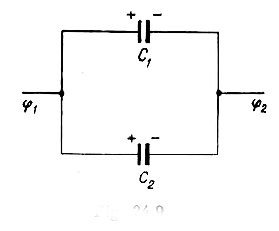Two capacitors with capacitances C1andC2 are connected in parallel. Find the resultant capacitance.
When the capacitors are connected in parallel (Fig. 24.9), all their interconnected plates have the same potential, therefore q1=C1(φ1−φ2)andq2=C2(φ1−φ2), where q1andq2 are the charges of the respective capacitors. The charge of the system is
q=q1+q2=(C1+C2)(φ1−φ2).
On the other h and q=C(φ1−φ2), where C is the equivalent capacitance. Hence the formula sought.

সম্পর্কিত প্রশ্ন
दो संधारित्रों की धारिताएँ क्रमशः C1 तथा C2 हैं। ये समान्तर क्रम में जोड़े जाते हैं। संयोजन की परिणामी धारिता कितनी होगी?
View Solutionसमान धारिता के दो संधारित्रों को श्रेणीक्रम में जोड़ने पर उनकी तुल्य धारिता C1 तथा समान्तर क्रम में जोड़ने पर C2 है तो C1/C2 का मान होगा।
View SolutionA capacitor or capacitance C1 is charge to a potential V and then connected in parallel to an uncharged capacitor of capacitance C2. The fianl potential difference across each capacitor will be
View SolutionFour capacitors of equal capacitance have a net capacitance C1 when connected in series and a net capacitance C2 when connected in parallel. The ratio of C1/C2 is
View SolutionFour capacitors of equal capacitance have an equivalent capacitance C1 when connected in series and an equivalent capacitance C2 when connected in parallel. The ratio C1C2 is
View SolutionTwo capacitors with capacitances C1andC2 are connected in series. Find the resultant capacitance.
View SolutionTwo capacitors with capacitances C_(1) and C_(2) are connected in parallel. Find the resultant capacitance.
View Solution
